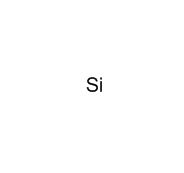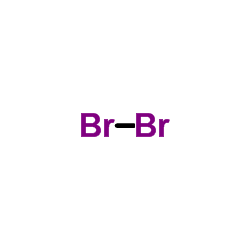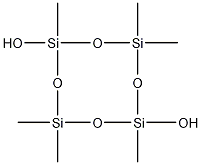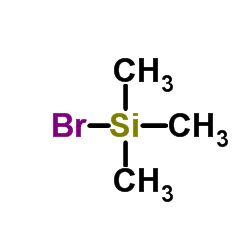7789-66-4
| Name | Silicon(IV) bromide |
|---|---|
| Synonyms |
EINECS 232-182-4
MFCD00049530 tetrabromosilane |
| Density | 2.8 g/mL at 25 °C(lit.) |
|---|---|
| Boiling Point | 153 °C(lit.) |
| Melting Point | 5 °C(lit.) |
| Molecular Formula | Br4Si |
| Molecular Weight | 347.70200 |
| Flash Point | 154°C |
| Exact Mass | 343.65000 |
| LogP | 3.00160 |
| Vapour density | 2.8 (vs air) |
| Index of Refraction | 1.5627 |
|
Section 1: Product Identification Chemical Name:Silicon (IV) bromide, 99+% CAS Registry Number:7789-66-4 Formula:SiBr4 EINECS Number:232-182-4 Chemical Family:metal halide Synonym:Silicon tetrabromide
Section 2: Composition and Information on Ingredients IngredientCAS NumberPercentACGIH (TWA)OSHA (PEL) Title Compound7789-66-4100%no datano data Section 3: Hazards Identification Extremely destructive to tissue of the respiratory tract, eyes and skin. Material hydrolyzes in contact with Emergency Overview: moisture releasing corrosive hydrogen bromide fumes. Primary Routes of Exposure:Ingestion, inhalation, skin, eyes Eye Contact:Liquid and vapors will cause burns to the eyes and blindness. Skin Contact:Corrosive to skin. Contact can lead to redness, pain, blistering, ulceration, and scar formation. Inhalation of choking fumes will result in burns to the respiratory tract, chemical pneumonitis and pulmonary Inhalation: edema. Ingestion:Ingestion is unlikely due to pungent choking odor. Causes burns to the gastrointestinal system. May be harmful if swallowed, inhaled or absorbed through the skin. Material is extremely destructive to tissue Acute Health Affects: of the mucous membranes and upper respiratory tract, eyes and skin. Chronic Health Affects:No information available on long-term chronic effects. NTP:No IARC:No OSHA:No SECTION 4: First Aid Measures Immediately flush the eyes with copious amounts of water for at least 10-15 minutes. A victim may need Eye Exposure: assistance in keeping their eye lids open. Get immediate medical attention. Wash the affected area with water. Remove contaminated clothes if necessary. Seek medical assistance if Skin Exposure: irritation persists. Remove the victim to fresh air. Closely monitor the victim for signs of respiratory problems, such as difficulty Inhalation: in breathing, coughing, wheezing, or pain. In such cases seek immediate medical assistance. Seek medical attention immediately. Keep the victim calm. Give the victim water (only if conscious). Induce Ingestion: vomiting only if directed by medical personnel. SECTION 5: Fire Fighting Measures Flash Point:not applicable Autoignition Temperature:none Explosion Limits:none Extinguishing Medium:none required If involved in a fire, fire fighters should be equipped with a NIOSH approved positive pressure self-contained Special Fire Fighting Procedures: breathing apparatus and full protective clothing. Hazardous Combustion andIf involved in a fire this material may emit corrosive hydrogen bromide fumes. Decomposion Products: Unusual Fire or Explosion Hazards: No unusual fire or explosion hazards. SECTION 6: Accidental Release Measures Small spills can be mixed with powdered sodium bicarbonate, lime, or calcium carbonate and swept up. Spill and Leak Procedures:Spillage in areas not adequately ventilated may require an evacuation of area. Emergency response teams will require self-contained breathing apparatus. SECTION 7: Handling and Storage Store material in a tightly sealed bottle away from moisture. If possible, handle material in an efficient fume Handling and Storage: hood. Exposure to the atmosphere may lead to degradation of the product. SECTION 8: Exposure Controls and Personal Protection Eye Protection:Always wear approved safety glasses when handling a chemical substance in the laboratory. Skin Protection:Wear protective clothing and gloves. Consult with glove manufacturer to determinew proper type of glove. Ventilation:If possible, handle the material in an efficient fume hood. In the absence of adequate ventilation a respirator should be worn. The use of a respiratory requires a Respirator: Respirator Protection Program to be in compliance with 29 CFR 1910.134. Ventilation:If possible, handle the material in an efficient fume hood. Additional Protection:Protective work clothing. SECTION 9: Physical and Chemical Properties Color and Form:colorless liq. Molecular Weight:347.72 Melting Point:5.4° Boiling Point:154°C Vapor Pressure:no data Specific Gravity:2.772 Odor:Pungent odor. Solubility in Water:reacts with water SECTION 10: Stability and Reactivity Stability:moisture sensitive Hazardous Polymerization:no hazardous polymerization Conditions to Avoid:contact with moisture Incompatibility:Water, alcohols, strong bases, and active metals. Decomposition Products:with moisture: hydrogen bromide and hydrobromic acid. SECTION 11: Toxicological Information RTECS Data:No information available in the RTECS files. Carcinogenic Effects:no data Mutagenic Effects:no data Tetratogenic Effects:no data SECTION 12: Ecological Information Ecological Information:No information available SECTION 13: Disposal Considerations Disposal:Dispose of according to local, state and federal regulations. SECTION 14: Transportation Shipping Name (CFR):Corrosive liquids, N.O.S. Hazard Class (CFR):8 Additional Hazard Class (CFR):NA Packaging Group (CFR):II UN ID Number (CFR):UN# 1760 Shipping Name (IATA):Corrosive liquid, N.O.S. Hazard Class (IATA):8 Additional Hazard Class (IATA):NA Packaging Group (IATA):II UN ID Number (IATA):UN# 1760 SECTION 15: Regulatory Information TSCA:Listed in the TSCA inventory. SARA (Title 313):Title compound not listed. Second Ingredient:none SECTION 16 - ADDITIONAL INFORMATION N/A |
| Symbol |

GHS05 |
|---|---|
| Signal Word | Danger |
| Hazard Statements | H314 |
| Precautionary Statements | P280-P305 + P351 + P338-P310 |
| Personal Protective Equipment | Faceshields;full-face respirator (US);Gloves;Goggles;multi-purpose combination respirator cartridge (US);type ABEK (EN14387) respirator filter |
| Hazard Codes | C: Corrosive; |
| Risk Phrases | R34 |
| Safety Phrases | S26-S27-S28-S36/37/39 |
| RIDADR | UN 3264 8/PG 2 |
| WGK Germany | 3 |
| Packaging Group | II |
| Hazard Class | 8 |
| Precursor 9 | |
|---|---|
| DownStream 10 | |

















